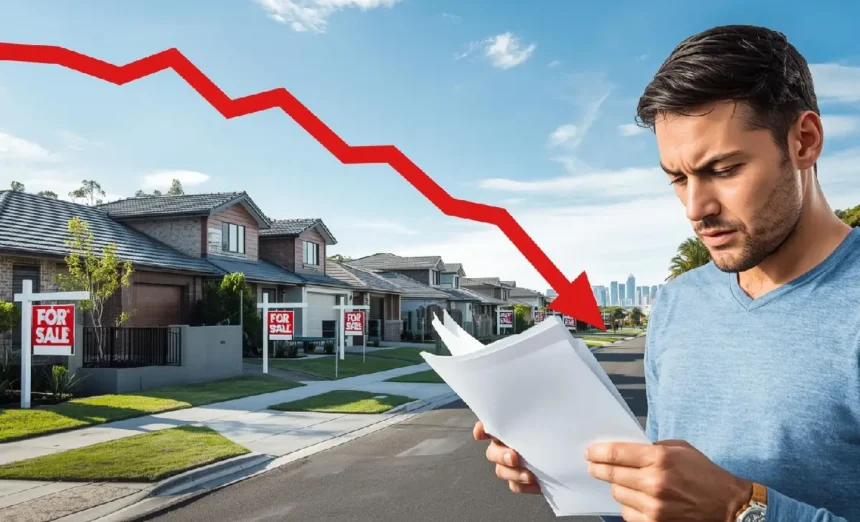Property investment promises financial freedom. But the reality? Not every investor walks away with profit.
Across Australia, countless investors lose money each year. They buy properties that never gain value, drain their savings on negative cash flow, or panic-sell at a loss. Understanding why property investments fail in Australia isn’t just useful—it’s essential if you want to protect your money and build real wealth.
This article breaks down the five most common reasons Australian property investments fail, backed by real examples and data. You’ll learn what mistakes to avoid and how to make smarter decisions from day one.
1. Lack of Proper Research and Due Diligence — The #1 Investment Killer
Most failed property investments start with one mistake: buying before doing the homework.
Many Australians rush into purchases based on gut feeling or a developer’s sales pitch. They skip the critical research that separates good investments from financial disasters. This includes understanding vacancy rates, population growth, infrastructure plans, and the local economy.
The cost of this mistake? Years of poor returns and thousands in lost capital.
1. Ignoring Local Market Trends
Every suburb has its own story. Some areas boom. Others stagnate or crash.
Investors who ignore local market trends often buy into oversupplied markets or declining regions. Between 2016 and 2019, inner-city Melbourne apartment investors learned this lesson the hard way. Developers flooded the market with high-rise units. Prices fell. Rental yields dropped. Many investors lost 20-30% of their property value within two years.
Before buying, check:
- Vacancy rates (aim for under 3%)
- Days on market for rentals
- New developments planned or under construction
- Major employers and economic drivers in the area
- Population growth trends
The Australian Bureau of Statistics provides suburb-level data that reveals these trends. Use it.
2. Skipping Financial & Legal Checks
A property might look perfect. But what’s hiding in the paperwork?
Skipping building inspections, pest checks, and strata reports leads to expensive surprises. Structural issues, pest damage, or upcoming special levies can destroy your investment returns overnight.
Essential due diligence tasks:
- Professional building and pest inspection
- Strata report review (for units/apartments)
- Contract review by a property lawyer
- Council zoning and development plans check
- Flood and fire risk assessment
- Title search for easements or restrictions
A $500 inspection now saves you $50,000 in repairs later.
2. Overleveraging and Poor Financing Decisions
Debt builds wealth—until it doesn’t.
Many Australian investors borrow too much, assuming rental income will cover everything. When interest rates rise, tenants leave, or unexpected costs hit, they can’t make repayments. Forced sales follow, often at a loss.
According to CoreLogic data from 2023, distressed property sales increased 18% when the Reserve Bank of Australia raised interest rates five times in twelve months. Overleveraged investors felt the pain first.
1. Misunderstanding Loan Structures
Interest-only loans look attractive. Lower monthly payments mean better cash flow—at first.
But when the interest-only period ends (typically 5-10 years), payments jump significantly. Principal and interest repayments on a $600,000 loan can increase by $1,200-$1,800 per month. Many investors aren’t prepared.
The trap: Investors rely on property value growth to refinance before this happens. When markets flatten or fall, they’re stuck with unaffordable repayments.
Smart approach:
- Calculate repayments at principal and interest rates from day one
- Stress test your budget at interest rates 2-3% higher than current
- Keep a cash buffer of at least $15,000-$20,000 per property
- Don’t assume rental income stays constant
2. Failing to Budget for Hidden Costs
Your mortgage isn’t your only cost.
First-time investors consistently underestimate holding costs. Land tax, council rates, property management fees, insurance, repairs, and maintenance add up fast. In New South Wales and Victoria, land tax alone can cost thousands annually once you cross the threshold.
Typical annual holding costs for a $600,000 investment property:
| Expense | Annual Cost |
|---|---|
| Council rates | $1,500-$2,500 |
| Water rates | $800-$1,200 |
| Landlord insurance | $600-$1,000 |
| Property management (7-8% of rent) | $2,500-$3,500 |
| Maintenance & repairs | $1,500-$3,000 |
| Land tax (if applicable) | $0-$5,000+ |
| Strata fees (units only) | $3,000-$8,000 |
Total potential annual costs: $10,000-$24,000 or more.
If your rental income doesn’t cover these costs plus mortgage repayments, you’re bleeding money every month.
3. Bad Timing in the Property Cycle
Markets move in cycles. Buy at the wrong time and you wait years just to break even.
Australian property markets don’t move in sync. Sydney might peak while Perth bottoms out. Regional areas surge while capital cities cool. Understanding these cycles isn’t optional—it’s the difference between profit and loss.
1. Buying in a Peak Market
Sydney 2017 tells the story perfectly.
Investors rushed in during the final stage of a boom. Prices hit record highs. FOMO drove decisions. Then the market corrected. Sydney median house prices fell approximately 15% over the next two years. Perth experienced a similar crash after 2014, with some suburbs dropping 20-30%.
Buyers who purchased at the peak faced years of negative equity. They couldn’t refinance. They couldn’t sell without taking massive losses. Some held on. Others gave up and walked away from deposits.
Warning signs you’re buying at a peak:
- Auction clearance rates consistently above 75-80%
- Property sitting on market for less than 15 days
- Multiple offers on every listing
- Prices rising faster than wage growth
- Media headlines talking about “property boom”
When everyone’s buying, step back and reassess.
2. Not Preparing for Economic Shifts
Interest rates change. Government policies change. Economic conditions change.
The Reserve Bank of Australia raised the cash rate from 0.1% in April 2022 to 4.35% by November 2023. Variable mortgage rates jumped from around 2% to 6%+. Investors who budgeted based on low rates suddenly faced thousands in extra annual repayments.
Government policy shifts hit hard too. APRA lending restrictions in 2014 and 2017 reduced borrowing capacity for investors. Suddenly, investors couldn’t refinance or expand their portfolios.
Smart investors plan for change:
- Assume interest rates will rise 2-3% during your ownership
- Monitor government policy announcements
- Diversify across markets and property types
- Maintain financial flexibility
The market rewards patience, not panic.
4. Poor Property Management
You bought in the right suburb. You timed the market well. You did your research. Then poor management ruins everything.
Even great properties underperform with bad management. Problematic tenants, maintenance delays, legal issues, and high vacancy periods destroy returns. Property management determines whether your investment generates income or headaches.
1. Self-Managing Without Experience
Managing your own rental saves money—about 7-8% of rental income annually. But it demands time, knowledge, and emotional control.
Many self-managing landlords make costly mistakes:
- Choosing tenants based on first impressions rather than proper screening
- Missing required rental inspections and maintenance
- Handling repairs incorrectly or too slowly
- Breaking tenancy laws (different in each state)
- Struggling to handle difficult tenant situations
One unlawful eviction attempt can cost you months of tribunal hearings and thousands in compensation. One missed maintenance issue can turn a $300 repair into a $5,000 insurance claim.
Self-management works if you understand your state’s Residential Tenancies Act, have time for inspections and repairs, and can remain professional during disputes. Most investors can’t commit to all three.
2. Hiring the Wrong Property Manager
Not all property managers deliver equal results.
Some communicate poorly. Some cut corners on tenant screening. Some let maintenance issues pile up. The wrong property manager costs you money through longer vacancy periods, problematic tenants, and unnecessary repairs.
Top 5 questions to ask before hiring a property manager:
- What’s your average vacancy period for properties in this area?
- How do you screen potential tenants?
- How quickly do you respond to maintenance requests?
- What’s your process for routine inspections?
- Can you provide references from current landlord clients?
Check their licensing with your state’s fair trading authority. Read online reviews. Ask for evidence of their claims.
A great property manager pays for themselves through lower vacancy rates, better tenant quality, and fewer repair emergencies.
5. Emotional vs Strategic Decision-Making
Numbers don’t lie. Emotions do.
The biggest difference between successful investors and failed ones? Successful investors make decisions based on data. Failed investors make decisions based on feelings.
Your emotions want a property you’d live in. Your wallet needs a property that generates strong returns. These aren’t always the same thing.
1. Buying Where You Want to Live
“I’d love to live there” is not an investment strategy.
Many investors buy in suburbs they personally like—near the beach, close to the city, or in trendy neighbourhoods. These areas often have low rental yields and premium prices. You’re paying extra for lifestyle appeal that tenants won’t pay for.
An investor who loves Bondi might buy a $1.2 million apartment earning 3% gross yield. Meanwhile, a western Sydney property at $650,000 earns 5% yield with stronger capital growth potential.
Investment properties should meet tenant demand, not your lifestyle preferences. Focus on:
- Schools and family facilities (for family tenants)
- Public transport and employment hubs (for professionals)
- Universities and affordable housing (for students)
- Affordability and essential services (for all tenants)
2. Letting FOMO or Trends Drive Decisions
The COVID-19 pandemic triggered a regional property boom. Australians fled cities for coastal and regional areas. Prices surged 30-40% in some towns within eighteen months.
Investors jumped in, assuming the trend would continue forever. It didn’t.
By mid-2023, many regional markets stalled or declined. Investors who bought at the peak faced negative equity and struggling rental markets. The temporary trend reversed when people returned to cities for work.
Trends create short-term price movements. Fundamentals create long-term value. Every boom eventually cools.
Ask yourself:
- Is this price increase driven by fundamentals or hype?
- Will demand stay strong in 5-10 years?
- Am I buying because everyone else is?
- Does the data support this purchase?
Let others chase trends. You chase fundamentals.
Conclusion
Property investment builds wealth for thousands of Australians every year. But only for those who approach it strategically.
Understanding why property investments fail in Australia gives you the advantage most investors lack. Avoid poor research, overleveraging, bad timing, management mistakes, and emotional decisions. Replace them with data, planning, professional advice, and patience.
Success doesn’t happen overnight. It happens through careful research, conservative financing, strategic timing, professional management, and disciplined decision-making.
Ready to start your property investment journey the right way? Check out our beginner’s guide to starting property investment in Australia with a small budget—and build your wealth on solid foundations, not wishful thinking.






